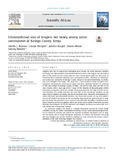Ethnomedicinal uses of stingless bee honey among native communities of Baringo County, Kenya
Date
2022-08-02Author
Kiprono, Sabella J.
Mengich, Gladys
Kosgei, Jackline
Mutai, Charles
Kimoloi, Sammy
Metadata
Show full item recordAbstract
Stingless bees live in tropical and subtropical areas around the world, however, stingless bee honey and other products have traditionally been used in the tropical and sub-tropical parts of the world to treat various diseases since ancient times. Little has been done to document these traditional medicinal uses, particularly in Africa. Therefore, an ethnomedical survey was conducted in Baringo County, Kenya to document knowledge on medicinal uses ofstingless bee honey. The study was a cross-sectional survey in which semi-structured questionnaires were used to collect data from randomly selected 327 residents in five sub-counties of Baringo County. Of these, 139 (42.5%) were men and 188 (57.5%) were women, with a mean age of 36.7 (range 18–94). Majority of the participants (29.8%) had primary education, 29.2% had attained secondary education and only 9.2% had no formal education. The results indicated that over 90% of the community members are not only aware of stingless bee honey, but also its medicinal uses. Treatment of respiratory disorders, infections, gastrointestinal disorders, sore throat and wounds are top most medicinal uses of stingless bee honey by the community. Importantly, the medicinal use of stingless bee honey was perceived to be associated only with mild side effects including nausea, throat irritation and loss of appetite, which are mainly due to intake of excessive amounts. Majority of participants 170 (52.8%) indicated that stingless be honey was not readily available despite the existing huge demand.
In conclusion, stingless bee honey is a popular therapeutic remedy for various health conditions among the native communities in Baringo County. Future pharmacological studies are needed to evaluate and validate the reported traditional therapeutic uses of stingless bee honey and its unique therapeutic properties. In addition, the potential of farming the local stingless bee species should be explored to meet demand and prevent overexploitation of the wild occurring stingless bee colonies.
URI
https://doi.org/10.1016/j.sciaf.2022.e01297https://www.sciencedirect.com/science/article/pii/S2468227622002046?via%3Dihub
http://ir-library.mmust.ac.ke:8080/xmlui/handle/123456789/2114
Collections
- Gold Collection [1026]

